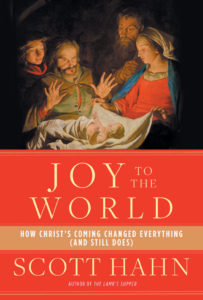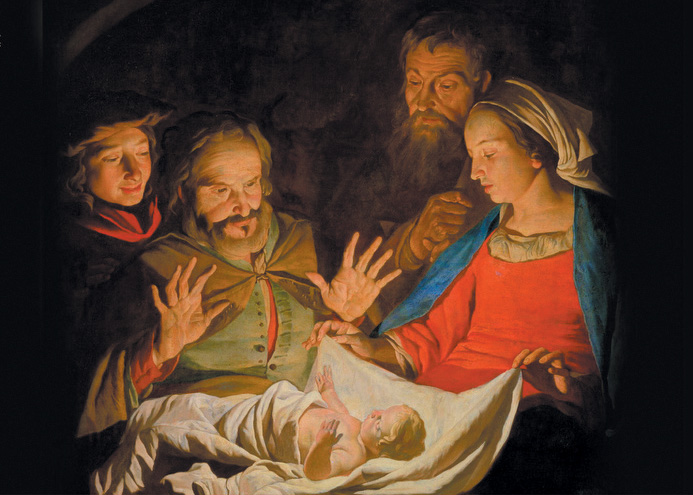[dropcap type=”4″]I[/dropcap]t’s Christmas time – Advent actually – so we Catholics need something “Christmas-y” and Scott Hahn’s new book, “Joy to the World: How Christ’s Coming Changed Everything (and Still Does),” cleverly fills that bill.

His book explores the value and meaning of the Nativity. The first thing he makes clear, and it is important for us all to consider in light of the New Evangelization, is that the Nativity is not a matter of folklore or fable but occurs solidly in the course of history, actual history of a man born in Israel who claimed to be the Son of God.
Hahn begins with the Gospels of Matthew and Luke which both render a history of the events. Matthew establishes genealogical ties to the entire history of Israel and Luke establishes the clearest and most accurate record of those events.
Matthew’s genealogy manifests a kinship in which Christ’s Nativity belongs to all of Israel and its history and a fulfillment of the words of the different prophets calling the exiled Jews back to prepare for the coming of the Chosen One — in Greek, Christos, the Christ.
[quote_box_left]

Joy to the World: How Christ’s Coming Changed Everything (and Still Does)
Publisher: Image Books
Author: Scott Hahn
Published: Oct. 21, 2014
Length: 175 pages, hardcover
Price: $23
ISBN: 9780804141123
Order: imagecatholicbooks.com
[/quote_box_left]
Luke deals with the genealogy much later in his narrative and pointedly works backward from Jesus to Adam, while Matthew works from Abraham to Jesus. The difference in Luke is understandable in terms of his intent — to establish Jesus as Savior of the whole world and not just the Messiah of Israel.
Hahn swings his attention toward the Virgin Mary, “the cause of our joy.” He details the significance of Mary in our physical world as inspiration for great cathedrals, the Sistine Chapel, and the greatest works of art from people like Bach and Michelangelo.
Hahn details the presence and purpose of Joseph, the “Holy Knight.” Joseph’s significance cannot be understated even though there is no recorded word of his anywhere in Scripture. His significance to Jesus is as an earthbound father who teaches his son the ways of the chosen people.
Hahn next waltzes through harking of angels, the little town of Bethlehem, the Magi, and
shepherds.
According to Hahn, angels are witnesses, created before the light. They are given free will as a precursor to our own and foreknowledge — as many saints and theologians have suggested — of the Incarnation. The angels’ choices, thus, become the dichotomy of heaven and hell, good versus evil, and the Christmas story is made central to the economy of salvation before it even happens in time and space.
Bethlehem, the birthplace of Jesus, is the center of what Hahn refers to as Davidic messianism, and therefore Christ’s validation as the Messiah, stems first not from what He says or does, but where He is from.
The Magi’s place in the Christmas story is an extreme counterpoint — something we never even think of — and it raises the story to an incredible place. The Magi were from Persia, a place loathed by both Jews and the Roman Empire; they were astronomers who measured the movement of stars and planets and claimed that the knowledge portended great events. Their beliefs were revolting to the Jews, and gravely disrespectful to the monotheistic worldview; so that when the three showed up bearing small earthly gifts as homage to the “newborn king of the Jews,” their real gift is the incredibility of their claim — the newborn king of the Jews!
Of course, the homage was sincere and set off a wave of infanticide perpetrated by Herod, but it served as one more example of how God used the inexplicable to tell the Christmas story.
And shepherds? Shepherds had no wealth or power; they owned no land and, by all accounts, shared that uniquely pungent fragrance with sheep. Yet, as with King David, who was also a shepherd, these shepherds came to pay homage and foretell the future reign of Christ as the shepherd of the people of God.
Hahn finishes by covering the Presentation, what he calls the “Flight into Joy,” as one can imagine escaping certain death at the hands of Herod a flight into joy, Holy trinities, heaven, and the Holy Family, sweeping the whole thing together into joy for the entire world. His premise is that the Christmas story has changed everything and that its eternal dynamics changes everything every single day. Who can argue against that?
This book is so “Christmas-y” that it is jacketed in red with a wonderfully classical painting of the Nativity on the front, light streaming Rembrandt style from the Child and more gifts inside than any of us will ever receive in our lifetimes.
Should you read this book? Do it now and see what happens when Christmas Day finally arrives.







